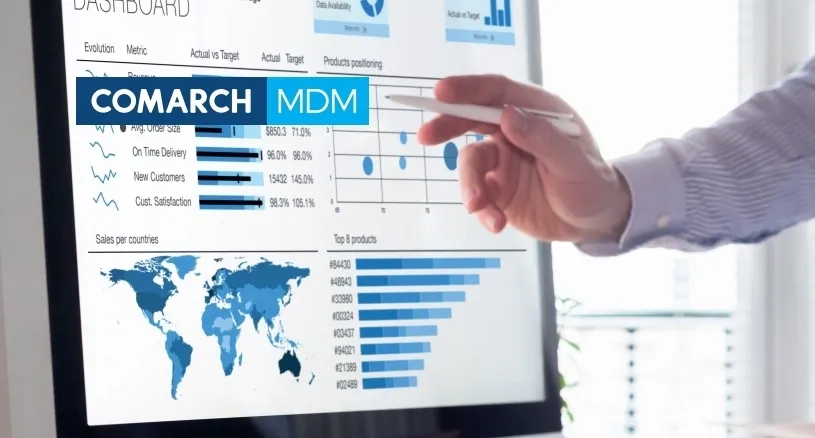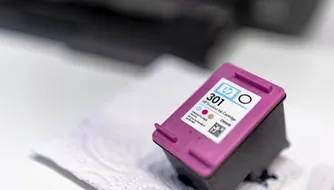What does it take to synchronize product data effectively?
Modern MDM technologies, global data synchronization network, synergy with EDI & more

To commercialize a new product, a company has to provide all relevant partners within the distribution network with accurate product data. A few years ago, it was sufficient to give the name of a particular product and its corresponding GTIN number. Later, the size and weight of the product were incorporated into the description. Today, comprehensive product data must include product category, packaging and labeling details, storage instructions, consumption instructions, and information on hazardous substances; basically everything that makes that particular product what it is.
Why is that? Because that is what end-customers pay ever more attention to. Product information is often one of the main drivers for choosing Product A, instead of Product B, or C. Plus, the data help distributors and retailers ship products more effectively – getting them to the right place at the right time so that they can be bought by target customers.
Keeping such detailed product information up to date across the entire distribution network, however, can be difficult. There are plenty of reasons, including the different ways of performing data exchange, the scope of possible product attributes, business partners using a range of data management systems, and so on. Not to mention that failure to provide high-quality data to all parties, on time, could lead to major financial setbacks. Fortunately, there are technologies that can help companies synchronize product data with their partners efficiently and economically. In this white paper, we will take a closer look at those solutions and the ways you can solve the challenges of product data synchronization across the entire distribution network.
2. The importance of data quality
Manufacturers and distributors often find themselves in situations when it is unclear which product their customer meant to order. If the GTIN (global trade item number) or product code is incorrect, or the description does not indicate a specific product, the delivered goods will be far from what was expected by the recipient. If a vendor takes a pallet instead of a box, for example, the sales and invoiced amounts will be significantly lower than they should be. The difference in size will affect the logistics – a loading unit will turn out to be too large or too small. A similar situation will take place in distribution centers where human resources and storage spaces are planned in accordance with orders. In the end, business partners on both sides will require extra time and resources to clarify the misunderstanding, and that will also lead to delayed payment.
For example, one of the retail chains that has approached Comarch held more than 4 000 stock-keeping units provided by their manufacturer. After a data cleaning process, which was done to eliminate duplicated or inaccurately described products, only a little more than 800 of these units remained. You can imagine how surprised the owners were when they found out that this disparity greatly affected their business efficiency – and not in a positive way.
Research carried out by several national branches of GS1 - a global, non-profit organization that develops and maintains global standards for business communication - shows that the quality of data is one of the key cost drivers in each supply chain. A survey by the British branch of GS1, covering major retail chains and manufacturers, revealed that data inconsistency occurs in about 80% of examined cases. Thus, duplicated GTINs, as well as missing or inaccurate attributes, have become part of everyday reality.
So, what is the price a company has to pay for using incorrect product data? GS1 US was quick to point out an increase in labor costs by up to 25%. They have also emphasized the fact that inventory inaccuracy may result in an 8.7% loss in sales. In their materials, GS1 US also refer to various product information management reports which reveal that 86% of consumers are unlikely to buy products from a given brand if they have experienced problems caused by incomplete or incorrect product information.
Considering that nearly two billion people are expected to purchase products online annually, making sure that they are provided the right information may be more than critical for a company’s success.
From the manufacturers' standpoint, the best situation would be if data recipients (such as retail chains) would agree on the same set of product attributes. In reality, however, many retail chains may need additional attributes to process data in their IT systems and realize their business strategies. Therefore, it is of utmost importance to provide partners with the right data at every level of a product launch and after.
The image below shows how product data are distributed across the supply chain and indicates the points at which errors are frequently made due to data being poorly prepared by the supplier.
3 The key challenges
3.1 PROVIDING ACCESS TO COMPLETE AND COHERENT INFORMATION REQUIRED BY FINAL CUSTOMERS
Many companies believe that effective product data synchronization between all partners in the supply chain is nearly impossible. Considering numerous attributes that one can assign to a given product and the fact that each company uses a different product data management system (or does so manually), it seems fairly reasonable for some to think that way.
If you are a manufacturer, there is a good chance that your partners will need some additional entries in your product data to run their sales channel operations efficiently. With thousands of pieces of product information being transferred from one part of the world to another, it can be quite overwhelming to try to control the flow. Being in control, however, is the only way to gain competitive advantage and drive better business results. With all modern data exchange technologies, such as Comarch’s MDM and EDI systems, companies need to realize that full synchronization of product data with all partners is possible, and that success largely depends on their approach.
3.2 CONVINCING ALL PARTNERS TO AGREE TO BUILD A SINGLE AND STANDARDIZED DATA EXCHANGE ENVIRONMENT
It is no secret that companies which are accustomed to their own ways of managing data exchange are cautious about turning to new technologies. After all, in their view, they have been collecting, storing, and processing their product data efficiently for years. The process might not have been perfect, as they were dealing with a lot of human errors along the way, but it worked – at least in theory.
And now, the same companies are afraid of losing all this information, or of migration being a highly expensive operation. Plus, they are not sure they will be able to convince their partners to become part of the new data exchange ecosystem. Therefore, the real challenge is to present them with solid, business-relevant arguments, ones that will assure them that creating an interoperable environment driven by product data actually pays off. But that’s not all.
It is of utmost importance to reach an agreement with your partners on whether a complete set of attributes is required right away, or whether it can be completed at later production stages (generally, for newly launched products). It must also be clear that the supplier is responsible for keeping product information available and up to date. And it is essential to determine what the process of giving approvals to updates in product data looks like for the entire supply chain.
3.3 HAVING A DEDICATED MDM DEPARTMENT
Our experience shows that most companies do not have a dedicated master data management department. As a result, the burden of collecting data from suppliers often falls on sales representatives who interact directly with customers. Also, they are the contact point for numerous departments such as manufacturing, logistics and marketing, and usually help them bring products to the market. The problem here, of course, is that they should not be focusing on being “product data middlemen.” Their job should be about building new connections and developing relationships with business partners – not about checking whether the numbers in Excel files are correct. Therefore, the challenge is to implement a robust MDM system and hire professionals who can help you govern it and solve potential system failures.
4. Best practices for a succesful MDM project
4.1. DEFINING NEEDS, STRATEGY, AND RESPONSIBILITIES
Every well-written story has a beginning, middle, and end. Efficient product data synchronization is no different in that way, and it starts with defining the needs that your company has to meet to drive the expected business results. No matter whether you are the supplier or distributor, before you make any decision on how to approach product information synchronization, you need to analyze your business profile, the scope of your company’s operations, the number of products you bring to the market, the number of business partners that you work with, and, most importantly, the reason you need to improve your product data exchange strategy.
If you are a supplier, and you develop your product data exchange strategy in a way that meets your company’s and your partners’ needs, you will be confident that the data that your company distributes across the entire supply chain is complete and of the highest quality. Ergo, you will also make your cooperation with distributors/retailers trouble-free and much more profitable (due to significantly fewer errors, the shortest time to market, and so on).
If you are one of the receivers of product data, however, and you determine the use and accuracy/consistency of core attributes such as the GTIN, product category, product description, size (length, height, width, weight, and volume) with your supplier, you will be able to provide your end-customers with the information that they need to decide whether they are going to buy a given product. If the product is to be offered online, it is also vital to ask the supplier for data that are critical from the end-customer’s perspective (ingredients, nutritional value, allergens, and storage, as well as high-quality photos). What is more, by defining the characteristics of the logistics hierarchy (the number of low-level items, the number of products per pallet layer, and the number of pallet layers), you will be able to transport and store products without any difficulties.
This planning, strategy-defining stage is also the right moment to establish relevant procedures for creating and updating product data. That also means possibly forming a dedicated IT department that would help govern all the operations, and delegating senior representatives of various departments (including sales, production, logistics, marketing and IT professionals) to be involved in the procedures. Of course, by working with an MDM & EDI technology provider such as Comarch, the supplier can expect the right level of support in the process of product data synchronization. That does not mean, however, that the supplier is free of its share of responsibilities. In other words, the producer has to act appropriately to set things in motion.
TIP 1: Product data cleansing and maintenance projects should have high C-level management attention and proper organizational support. Due to the engagement of various departments, the roles and responsibilities as well as KPIs, have to be defined.
4.2. THE GLOBAL DATA SYNCHRONIZATION NETWORK (GDSN) MAY BE TOO COMPLEX FOR SMALL PARTNERS
The Global Data Synchronization Network, or GDSN for short, is a network of interoperable data pools that allows all trading partners to securely synchronize master data created on the basis of GS1 standards. Supporting real-time data sharing, it guarantees that any product update will be instantly reported to trading partners’ databases.
The core element of GDSN is the Global Registry, which contains identifiers for all products (rather than complete data) derived from certified product pools (around 40 entities globally). The registry communicates with all certified data pools by means of standard registration and subscription messages, in the format of defined XML files. The data are published and synchronized directly between the pools (without the involvement of the registry).
Synchronization is carried out continuously at the request of the data recipient (via subscription). That’s what keeps product information up to date, accurate, and complete at all times. The exchange of data uses the Global Location Number (GLN) and the Global Trade Item Number (GTIN) numbers – data exchange standards developed by GS1 - for finding and specifying organizations and their corresponding products.
It is also important to point out that, in the GDSN, the supplier is responsible for the quality of provided data as part of the obligation to keep all partners informed about any changes. This is yet another reason why the network facilitates the exchange of product data across all sales channels, and it also explains why companies such as Comarch have turned their MDM systems into a certified GDSN data pool as well.
TIP 2: For some suppliers, it may be too complex to operate within the GDSN framework. Thus, some retailers should think of an MDM solution, which is able to guarantee either data flow via GDSN, or a simplified one that guarantees a comprehensive approach to data from all suppliers.
4.3. A MODERN MDM SYSTEM WITH INNOVATIVE FEATURES – CALL FOR TENDER FUNCTIONALITY AS AN EXAMPLE
A master data management system – commonly known only as MDM – works as sort of a central hub that harmonizes and organizes product information and puts it in sync with the systems used by business partners. It eliminates chaotic email or paper-based communication by providing each authorized party with instant access to product data that is verified in real time.
A basic MDM system can help you optimize your business operations effectively. To improve the overall efficiency of data exchange even further, however, you can use a modern MDM system, a platform that goes beyond the basic principles of data exchange and delivers features and functionalities that provide data-driven enterprises with a real competitive advantage.
Call for tenders
The modern MDM system developed by Comarch engineers gives retailers the opportunity to execute call for tenders to gather available product on the market. Thus, it allows suppliers to include more products in the retailer's offer. Our system also enables a retailer to send inquiries, collect and manage offers from its business partners, and find products in the directory encompassing all trading partners. Thus, as a retailer, you can send a query to suppliers who use our MDM solution about a particular type of product.
All interested suppliers can respond to that query by presenting you with some additional information – what kind of product they can provide – that encompasses both the products that are published in the system and those that are still being developed. Being given several similar product offers, you can choose those that best meet your requirements. At that moment, you will be presented with a complete product card that will include much more detailed information, including the price.
Such functionalities work only when the data source and data recipient are of Comarch origin, yet they are real game-changers in terms of improving the efficiency of master data exchange between all business partners. You can also take it to the next level.
TIP 3: Your modern MDM solution should be able to provide features guaranteeing product lifecycle management. It should cooperate with demand and planning systems, as well as with the tools for executing promotions by the retailers.
4.4. SYNERGY WITH EDI
Maximized time efficiency, reduced operational costs, validation of documents, a single channel of communication, and integration with individual apps - these are but a few of the many advantages that result from using electronic data interchange (EDI) and master data management (MDM) systems delivered by a single provider. How does it look in practice? Well, there are many possibilities.
First, by using systems provided by a single vendor such as Comarch, a client can be 100 per cent sure of their full compatibility. Ergo, the recipients are required to perform only minimal system configuration, concerning customizing the product data model to their requirements. In the case of suppliers who use a web-based solution, there is no need for any additional configuration. It is necessary, however, if a supplier chooses the file integration option.
Second, we have designed our platforms in a way that allows a supplier first to create product data in a system of their choice (in one of the fixed formats), and then send that data to our MDM application via the EDI Platform. At that point, it is our responsibility to check whether that particular piece of information is correct and complete. If the file is correct, we can upload that data straight into the Comarch MDM system. This means a supplier does not need to enter product information into the MDM manually or via Excel file upload. If it is correct, one file is sufficient. This has proven to be one of the most time and cost-effective methods of achieving full product data synchronization. But that’s not all.
Third, we are perfectly aware that some clients use more than one system to create their product data. Therefore, to avoid having to deal with differences in the outcomes, we can use EDI and MDM to harmonize the information flow. Let’s clarify that by providing you with a real-life example. There can be a situation where a supplier is using three different systems to create product information, for instance, CRM, ERP, and WMS. Files created in those systems can later be sent via the Comarch EDI platform, where they will be validated and integrated into a single, interoperable file, which will then be entered into Comarch MDM and, ultimately, distributed among the supplier’s partners. It is also important to mention that, although we have presented this procedure and its benefits from the supplier’s point of view, the recipient of product data gains similar advantages.
Fourth, a buyer has the opportunity to check whether an order, invoice, confirmation of shipment, or any other document that includes product information, matches the data stored in the MDM system.
TIP 4: Thanks to the integration of EDI with MDM, the company can be certain that the quality of collected data and optimization of supply chain processes will be improved significantly. Choose a provider who is able to provide both solutions and has the capabilities to integrate with your IT environment.
4.5. PARTNER ONBOARDING
There is one more subject that we need to address. Some of your partners (and you yourself) may be skeptical about the onboarding process, thinking that it probably is quite difficult and expensive.
At Comarch, it was our priority to make this process as seamless as possible. And thanks to more than 25 years of experience in the field of IT, we provide all the right tools and support to help you start using our systems in no time. If we could give you one piece of advice on how to convince your partners to join the new ecosystem driven by product data it would be this - provide them with all the information discussed up to this point, and tell them about your own experiences. The benefits of a modern MDM system, the GDSN, and synergy between MDM and EDI, speak for themselves. And if you put them all in the context of your business and the entire distribution network, it will become clear why it is you want to make a change. Also, when you consider how many companies are becoming part of the GDSN network, and how many are in the process of implementing a modern MDM system, you will realize that the sooner you make the decision, the sooner you and your partners will be able to achieve better business results.
TIP 5: As connecting partners to the platform is one of the crucial steps and requires experience and selection of the right strategy, it’s very important to find a provider with proven experience in the onboarding process and enabling self-onboarding tools and verified procedures.
5. Choosing an MDM provider
It is important that the solution for product master data management you choose is adapted to your needs. In selecting, one you should be aware that it is not just about how fast information is distributed among buyers and suppliers. It is also about the quality and transparency of the exchanged data and the opportunities that it offers you relating to data management.
To help companies face all these challenges, we deliver Comarch Master Data Management – a cloud-based, GDSN certified data pool that allows you to organize, verify, manage, and maintain business-relevant information with ease.
Not only does our product eliminate chaotic email or paper communication - frequently resulting in double data entry or human error - but it can also be integrated with your internal master data systems to improve data flow. As a result, Comarch MDM enables you to optimize your business operations and achieve better results in no time.
If you want to know more about Comarch products for improving data efficiency (MDM, EDI, E-Invoicing and Online Distribution), please visit our official website: https://www.comarch.be/nl/data-management/
Inloggen/registreren
Om deze content te lezen, moet u zich inloggen.
Log in of registeer nu via onderstaande knop en krijg toegang tot deze inhoud.


